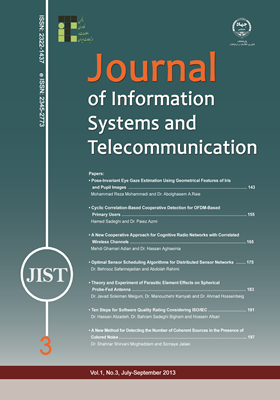Theory and Experiment of Parasitic Element Effects on Spherical Probe-Fed Antenna
محورهای موضوعی : Electromagnetic, Antenna and PropagationJavad Soleiman Meiguni 1 , Manouchehr Kamyab 2 , Ahmad Hosseinbeig 3
1 - Electrical and Computer Engineering
2 - K. N. Toosi
3 - K. N. Toosi
کلید واژه: Asymptotic Approximation, Dyadic Green’s Function, Spherical Probe-Fed Antennas,
چکیده مقاله :
Theory and experiment of a spherical probe-fed conformal antenna with a parasitic element mounted on a spherical multilayer structure are presented in this paper. Rigorous mathematical Method of Moments (MoMs) for analyzing various radiating spherical structures is presented in this paper by using Dyadic Green's Functions (DGFs) in conjunction with Mixed Potential Integral Equation (MPIE) formulation. Linear Rao-Wilton-Glisson (RWG) triangular basis functions are applied in MPIE formulation. Current distributions on coaxial probe and conformal radiating elements are computed by using spatial domain Dyadic Green's Function (DGF) and its asymptotic approximation. A prototype of such an antenna is fabricated and tested. The effect of the parasitic element on the input impedance and radiation patterns of the antenna is investigated. It is shown that the antenna characteristics are improved significantly with the presence of the conducting parasitic element. Good agreement is achieved between the results obtained from the proposed methods and the measurement results.
Theory and experiment of a spherical probe-fed conformal antenna with a parasitic element mounted on a spherical multilayer structure are presented in this paper. Rigorous mathematical Method of Moments (MoMs) for analyzing various radiating spherical structures is presented in this paper by using Dyadic Green's Functions (DGFs) in conjunction with Mixed Potential Integral Equation (MPIE) formulation. Linear Rao-Wilton-Glisson (RWG) triangular basis functions are applied in MPIE formulation. Current distributions on coaxial probe and conformal radiating elements are computed by using spatial domain Dyadic Green's Function (DGF) and its asymptotic approximation. A prototype of such an antenna is fabricated and tested. The effect of the parasitic element on the input impedance and radiation patterns of the antenna is investigated. It is shown that the antenna characteristics are improved significantly with the presence of the conducting parasitic element. Good agreement is achieved between the results obtained from the proposed methods and the measurement results.


